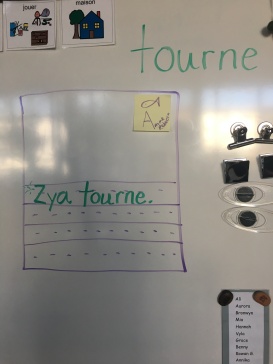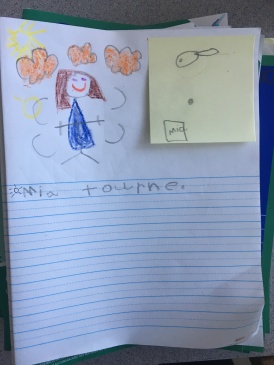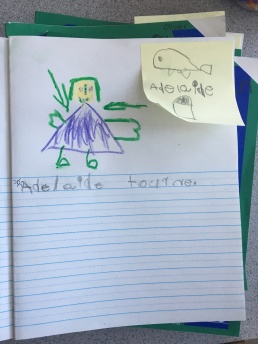 Our learning continues to be grounded in the Spirit of Alliances. Please read my previous posts for more background information on this. We have an ongoing dialogue about how we learn best, which is rooted in the four Spirit of Alliance animals. For instance: I would like to work on using kind words with my friends when I feel frustrated like the Wolf, or I would like to keep trying to remember to use a finger space when writing in my journal to show the space between my words. We are setting goals, each morning after our mindfulness time, on how we can improve our learning and our actions throughout the day. The intention setting and strategic monitoring using various visuals, check-ins and journal entries has been successful for our learners, however I wanted to extend our learning intentions deeper and further.
Our learning continues to be grounded in the Spirit of Alliances. Please read my previous posts for more background information on this. We have an ongoing dialogue about how we learn best, which is rooted in the four Spirit of Alliance animals. For instance: I would like to work on using kind words with my friends when I feel frustrated like the Wolf, or I would like to keep trying to remember to use a finger space when writing in my journal to show the space between my words. We are setting goals, each morning after our mindfulness time, on how we can improve our learning and our actions throughout the day. The intention setting and strategic monitoring using various visuals, check-ins and journal entries has been successful for our learners, however I wanted to extend our learning intentions deeper and further.
Looking at how I might shift our daily learning intentions to become more focused intentions I reflected on the fact that I did not want to stop setting daily intentions, but I wanted to add in more opportunities to set specific intentions for specific activities. I also realized that if I hope for my learners to set more specific intentions, then we would need to be co-constructing specific outcomes and expectations for each activity (more than we already have been). This might look like setting goals specifically for an inquiry, numeracy, literacy activity or during a play exploration time.
I decided to try this out with a more structured activity that concretely aligns with a co-constructed criteria. After the winter holiday break, we have begun a new journal that has us writing on lines. Last term, we had been working on creating ‘Big, Bold and Beautiful’ illustrations that tell a story and then printing our names. This term we have begun journaling about ourselves doing actions. For instance, Rebecca jumps. In French Immersion journaling and invented spelling can be a tricky concept for writing, and I find you have to introduce some key words through modelling and then almost go backwards towards invented spelling. The vocabulary needs to be there in order for the children to sound out and spell independently. I also attended a great AIM language workshop by Karen Oraas (a teacher in the Victoria School District) which sparked some more great extensions for journaling in Kinder French Immersion. For our new journal activities, we have co-constructed a criteria with new learning taken from our morning message. We have learned that sentences start with a capital letter and end with a period. We thought these would be two great points for our journal criteria. We also have been practicing starting at the top for our letter formation, at the sun and going down to the ground. We have also learned that words have spaces between them and we can use our finger to create this space. So there we had it, four points for our criteria.
We talked about how we set our learning intentions for each day, but how it is a good idea to set intentions for other parts of our day too. We decided that these intentions might be different than our overall day intention, and this is a good thing. “You can be more than one animal in one day and that’s actually really good! Because then you are even more thoughtful” -Kindergarten friend shared. We agree that our intentions would still be based on one of the Spirit of Alliance animals but would also need to connect to one of the criteria pieces for the activity. Connecting this back to our journal activity, most children decided they would be like the Salmon (persevering) on one criteria piece, for instance: I am going to be like the Salmon and work on remembering to end my writing with a period.
 Together we discussed our co-constructed criteria and I made a visual representation, with a code for each criteria piece, on our board. I modeled how they were to use a sticky note and begin by printing their name, then quickly outlining which Spirit of Alliance animal their intention was rooted in and then draw the ‘code’ for their chosen focus piece of criteria. I found because our journal routine was already somewhat practiced from last term, the intention setting activity went smoothly and was not too much more for them to take on.
Together we discussed our co-constructed criteria and I made a visual representation, with a code for each criteria piece, on our board. I modeled how they were to use a sticky note and begin by printing their name, then quickly outlining which Spirit of Alliance animal their intention was rooted in and then draw the ‘code’ for their chosen focus piece of criteria. I found because our journal routine was already somewhat practiced from last term, the intention setting activity went smoothly and was not too much more for them to take on.
 We set our intentions together and then I modeled referring to their intention throughout the journaling activity. I modeled sticking their sticky note in the corner of their journal page and using it as a check-in point before they started their illustration. As I supported and moved around the room, I could hear them using similar language and orally checking-in independently. I noticed that some of them got out erasers to make changes or edits, and some came up to show me that they had remembered their focus and included in their work.
We set our intentions together and then I modeled referring to their intention throughout the journaling activity. I modeled sticking their sticky note in the corner of their journal page and using it as a check-in point before they started their illustration. As I supported and moved around the room, I could hear them using similar language and orally checking-in independently. I noticed that some of them got out erasers to make changes or edits, and some came up to show me that they had remembered their focus and included in their work.
They were beaming with  excitement to show me their work. The oral narrative of them checking in with their intentions was powerful to witness!
excitement to show me their work. The oral narrative of them checking in with their intentions was powerful to witness!
 As we are looking forward we will be starting to look at setting learning intentions for our exploration play time! These intentions will most-likely be structured more around social interactions, but perhaps clean-up responsibilities and persevering with building and creating as well. We shall see what our co-constructed criteria will look like. Stay tuned for more to come!
As we are looking forward we will be starting to look at setting learning intentions for our exploration play time! These intentions will most-likely be structured more around social interactions, but perhaps clean-up responsibilities and persevering with building and creating as well. We shall see what our co-constructed criteria will look like. Stay tuned for more to come!
Thanks for reading,
Rebecca
